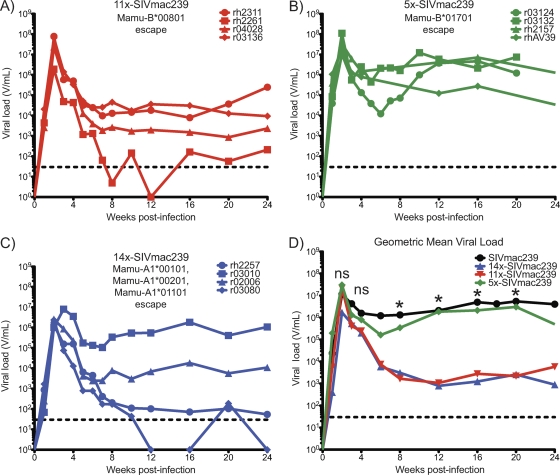Fig. 2.
Viral loads following mutant SIVmac239 virus infection. We infected four rhesus macaques with each of the indicated viruses. We measured viral loads with a previously described method (23). Viral loads of ≥30 viral RNA copies per ml of plasma (V/ml; dashed lines) can be reliably quantified using this method. (A to D) 11x-SIVmac239 (carrying Mamu-B*00801-restricted T cell epitope mutations) (A) and 14x-SIVmac239 (carrying Mamu-A1*00101-, Mamu-A1*00201-, and Mamu-A1*01101-restricted T cell epitope mutations) (C) do not replicate in vivo as well as 5x-SIVmac239 (carrying Mamu-B*01701-restricted T cell epitope mutations) (B) and wild-type SIVmac239 (D). (D) Geometric mean viral loads were calculated for each group of infected animals (n = 4) and wild-type SIVmac239-infected historical controls (n = 33). A Kruskal-Wallis test was performed with Dunn's multiple-comparison posttest comparing viral loads at the indicated time points postinfection among all wild-type SIVmac239-infected animals and each of the three mutant virus-infected groups of animals. Significant differences were discovered at weeks 8, 12, 16, and 20 postinfection in comparisons of 11x-SIVmac239-infected animals to wild-type SIVmac239-infected animals and of 14x-SIVmac239-infected animals to wild-type SIVmac239-infected animals (ns, not significant; *, P < 0.05). No significant differences were detected between 5x-SIVmac239- and wild-type SIVmac239-infected animals.

